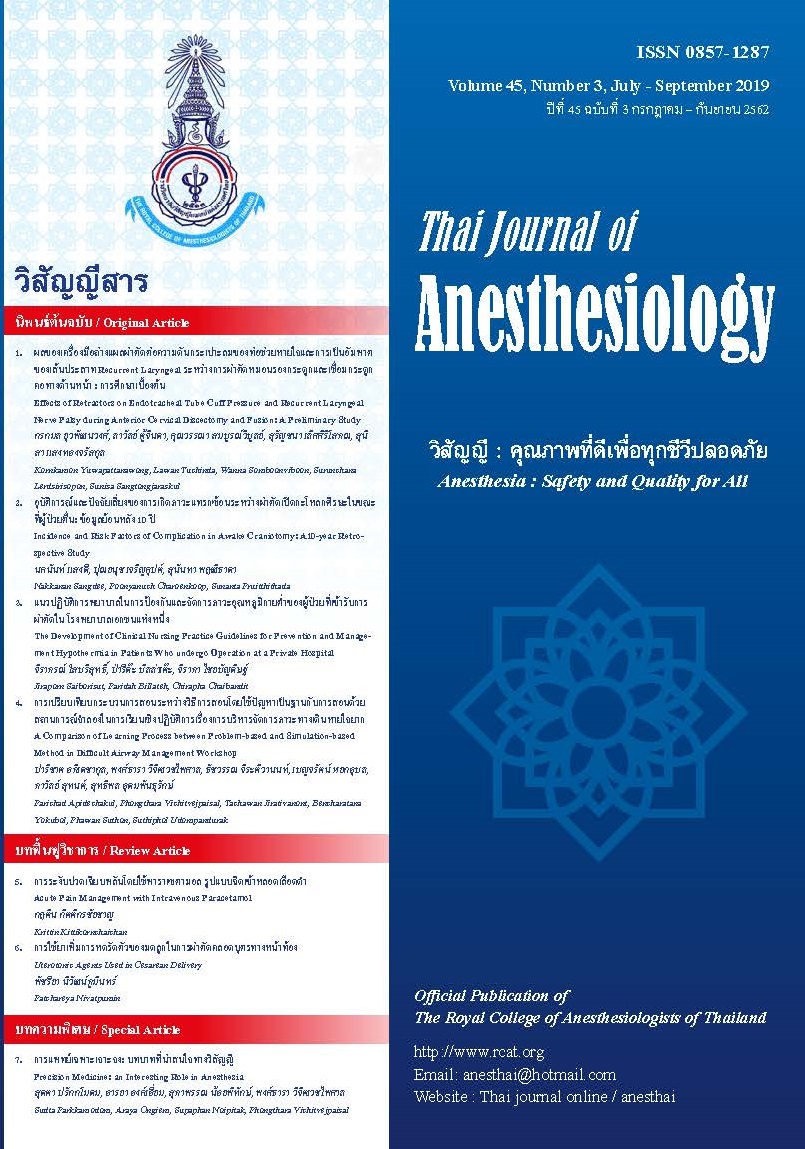The Development of Clinical Nursing Practice Guidelines for Prevention and Management Hypothermia in Patients Who undergo Operation at a Private Hospital
Main Article Content
Abstract
Background: Hypothermia is a common incidence in
patients who underwent surgery under anesthesia, which
may result in various complications. Therefore it is necessary
to develop nursing practice guidelines to prevent
hypothermia.
Objective: To develop and evaluate the effectiveness of
clinical nursing practice guideline (CNPG) for prevention
and management hypothermia in patients who underwent
operation at Bangkok Hospital Hatyai.
Methods: The clinical nursing practice guideline was
developed by using an evidence-based practice. Its
contents include hypothermia risk assessment, nursing
management during pre-operation; peri-operation and
post-operativon were validated by three experts. The first
draft CNPG was tested and evaluated for its possibility
before the finally CNPG was implemented in the hospital.
An incidence of hypothermia was continuously monitored.
Data were analyzed using descriptive statistic; frequency,
percentage and mean.
Results: There was no hypothermia case during the pilot
time. After implemented this CNPG, the incidence of
hypothermia in surgical patients was decreased from 39.5
to 3.1-5.0 percent. Nurses reported that the CNPG was
easy to use, practical and highly satisfied.
Conclusion: The clinical nursing practice guideline for
prevention and management hypothermia is suitable and
effective to reduce hypothermia in patients undergoing
surgery in Bangkok Hospital Hatyai.
Article Details
References
1. Suwandalat N, Yimrattanabavorn P, Maneesawangwong S,
Nuttakul T. A comparative study of prevent hypothermia in
children during the body wrap between cotton rolls with
electric blankets and plastic sheet. Thai J Anesthesiology
1995;2:113-8.
2. Hegarty J, Walsh E, Burton A, Murphy S, O’Gorman F,
McPolin G. Nurses’knowledge of inadvertent hypothermia.
J Adv perioperat Care 2009;4:33-42.
3. Weirich LT. Hypothermia/ Warming protocals: Why are they
not widely used in the OR? AORN Journal 2008; 7: 333-44.
4. Prakanrat A., Suwanjinda W. Textbook of anaesthesia. 3rd
edition. Bangkok: Bangkok Wetchasan Printing House; 2005.
5. Sessler DI. Complication and treatment of mild hypothermia.
Anesthesiology 2001;95:534-43.
6. Buggy DJ, Crossly AW. Thermoreguration, Mild perioperative
hypothermia and post anesthetic shivering. Br J Anaesth
2000;84:615-28..
7. Witte M, Sessler DJ. Perioperative shivering. Anesthesiology
2002;96:457-84.
8. Charuluxananan S. Textbook of anaesthesia: complications
from anesthesia. Bangkok: WinPress Production House;
2007.
9. Charchote S. The development of clinical nursing practice
guidelines to prevent hypothermia in adult abdominal
surgical patients under general anesthesia at Magarug
Hospital Kanchanaburi Province. [Master Thesis] Bangkok:
Christain University of Thailand; 2007.
10. Pisitsak C, Virankabutra T, Deewong K, Pornprasertsuk M.
Postoperative Hypothermia: Incidence and Associated
Factors. Thai J Anesthesiology 2011;37:93-102.
11. de Brito poveda V, Clark AM, Galvao CM. A systematic review
on the effectiveness of prewarming to prevent perioperative
hypothermia. J Clin Nurs 2012;22:906-18.
12. Torossian A, Brauer A, Hocker J, Bein B, Wulf H, Horn E.
Preventing Inadvertent perioperative hypothermia. Dtsch
Arztebl Int 2015; 112: 166-72.
13. American society of perianesthesia nurse. Clinical guideline
for the prevention of unplanned perioperative hypothermia.
J Perianesth Nurs 2001; 305-13.


